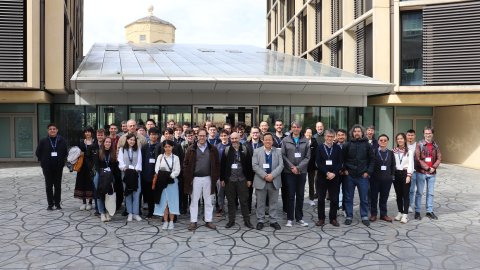12:00
A new understanding of the grazing limit
Abstract
The grazing limit of the Boltzmann equation to Landau equation is well-known and has been justified by using cutoff near the grazing angle with some suitable scaling. In this talk, we will present a new approach by applying a natural scaling on the Boltzmann equation. The proof is based on an improved well-posedness theory for the Boltzmann equation without angular cutoff in the regime with an optimal range of parameters so that the grazing limit can be justified directly that includes the Coulomb potential. With this new understanding, the scaled Boltzmann operator in fact can be decomposed into two parts. The first one converges to the Landau operator when the parameter of deviation angle tends to its singular value and the second one vanishes in the limit. Hence, the scaling and limiting process exactly capture the grazing collisions. The talk is based on a recent joint work with Yu-Long Zhou.
12:00
Non-regular spacetime geometry, curvature and analysis
Abstract
I present an approach to Lorentzian geometry and General Relativity that does neither rely on smoothness nor
on manifolds, thereby leaving the framework of classical differential geometry. This opens up the possibility to study
curvature (bounds) for spacetimes of low regularity or even more general spaces. An analogous shift in perspective
proved extremely fruitful in the Riemannian case (Alexandrov- and CAT(k)-spaces). After introducing the basics of our
approach, we report on recent progress in developing a Sobolev calculus for time functions on such non-smooth
Lorentzian spaces. This seminar talk can also be viewed as a primer and advertisement for my mini course in
May: Current topics in Lorentzian geometric analysis: Non-regular spacetimes
Oxford Women and Non-Binary in Mathematics Day 2024: Beyond the Pipeline
Abstract
 The conference ‘Beyond the Pipeline: Women and Non-binary People in Mathematics Day’ will be held at the University of Oxford on the 17th February 2024. This is a joint event between the Mathematrix and the Mirzakhani societies of the University of Oxford. It is kindly funded by the London Mathematical Society and the Mathematical Institute at the University of Oxford, with additional funding from industry sponsors.
The conference ‘Beyond the Pipeline: Women and Non-binary People in Mathematics Day’ will be held at the University of Oxford on the 17th February 2024. This is a joint event between the Mathematrix and the Mirzakhani societies of the University of Oxford. It is kindly funded by the London Mathematical Society and the Mathematical Institute at the University of Oxford, with additional funding from industry sponsors.
The metaphor of the 'leaky pipeline' for the decreasing number of women and other gender minorities in Mathematics is problematic and outdated. It conceals the real reasons that women and non-binary people choose to leave Mathematics. This conference, 'Beyond the Pipeline', aims to encourage women and non-binary people to pursue careers in Mathematics, to promote women and non-binary role models, and to create a community of like-minded people.
Speakers:
- Brigitte Stenhouse, The Open University
- Mura Yakerson, The University of Oxford
- Vandita Patel, The University of Manchester
- Melanie Rupflin, The University of Oxford
- Christl Donnelly, The University of Oxford
The conference will also include:
- A panel discussion on careers in and out of academia
- Talks by early-career speakers
- Poster presentations
- 1:1 bookable appointments with our industry sponsors (Cisco, Jane Street, ING, and Optiver)
- Careers stands with our sponsors and the IMA
More information can be found on our website https://www.oxwomeninmaths2024.co.uk/.
This conference is open to everyone regardless of their gender identity. Registration is via the following google form https://forms.gle/cDGaeJCPbBFEPfDB6 and will close when we have reached capacity. We have limited travel funding to support travel to Oxford from within the UK and you can apply for this on the registration form. The deadline for those applying to give a talk and for those applying for travel funding is the 27th January.
If you have any questions email us at @email.
Characteristic polynomials, the Hybrid model, and the Ratios Conjecture
Abstract
In the 1960s Shanks conjectured that the ζ'(ρ), where ρ is a non-trivial zero of zeta, is both real and positive in the mean. Conjecturing and proving this result has a rich history, but efforts to generalise it to higher moments have so far failed. Building on the work of Keating and Snaith using characteristic polynomials from Random Matrix Theory, the Hybrid model of Gonek, Hughes and Keating, and the Ratios Conjecture of Conrey, Farmer, and Zirnbauer, we have been able to produce new conjectures for the full asymptotics of higher moments of the derivatives of zeta. This is joint work with Chris Hughes.
Asymptotic freeness in tracial ultraproducts
Abstract
I will present novel freeness results in ultraproducts of tracial von Neumann algebras. As a particular case, I will show that if a and b are the generators of the free group F_2, then the relative commutants of a and b in the ultraproduct of the free group factor are free with respect to the ultraproduct trace. The proof is based on a surprising application of Lp-boundedness results of Fourier multipliers in free group factors for p > 2. I will describe applications of these results to absorption and model theory of II_1 factors. This is joint work with Adrian Ioana.



